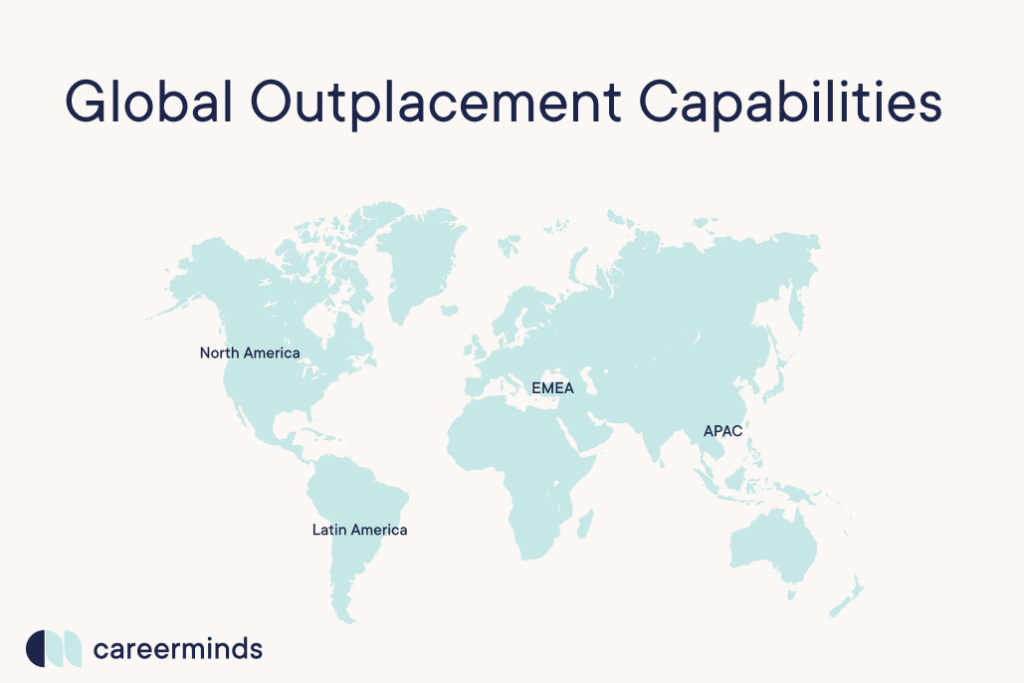
Compare Providers
Download our outplacement comparison sheet
Request Pricing
Compare our rates to other providers
Choosing a global outplacement provider can be a daunting task. What features should a top-notch provider have? What are the differences between different programs? What are the cultural norms in the various countries about the type of services provided?
We’ve already provided a lot of tips on how to shop for outplacement in general. However, when you’re looking for global outplacement services, it gets a bit more complicated. So it requires even more explanation to ensure that you are choosing the right provider that fits your needs and the needs of your displaced workers.
Global Outplacement: How It Works
Outplacement, as a refresher, is a service offered to displaced workers that helps them land a new role outside of their current organization.
Global outplacement extends the reach of local outplacement programs to help companies with employees spread over large geographical regions. In today’s world of virtual work and dispersed workforces, global outplacement helps organizations provide support to their staff members wherever they happen to be located.
So how does it actually work?
There are many different ways a global outplacement provider can extend their support across an organization’s various countries, cultures, and languages. Many outplacement providers rely on outsourcing to partner networks to deliver global outplacement support, which can often impact the quality of the program.
At Careerminds, our philosophy with global outplacement is a one firm approach. What does that mean? Careerminds carefully recruits and trains global coaches who can deliver global outplacement consistently around the globe, leveraging one comprehensive platform and client portal, and delivering transparent results to our customers.
Our outplacement program is primarily virtual, allowing workers to obtain our services from the comfort of their homes and on their own schedule. However, in countries where face-to-face is still in demand, programs are blended to offer on-demand face to face support with virtual delivery.
The process of procuring for a global outplacement provider usually begins with an RFP (or Request For Proposal). We have some tips and templates on how to get started with your own RFP here if you are ready to begin your search for global outplacement services.
The Benefits of Global Outplacement
We’ve been talking about how global outplacement works, so now let’s talk about why you should consider providing outplacement in the first place. There are many benefits to providing outplacement, and this becomes especially true for outplacement services that provide global support.
The biggest benefit is that your employees will be able to make an exit from your organization and land a new role elsewhere with the help of a support system that’s there with them every step of the way. This is one of the best things a company can do for their staff members who are going through one of the hardest professional transitions in their lives.
Outplacement also allows companies to navigate difficult business decisions. No one likes to hold a reduction-in-force (RIF) or layoff event, but they are sometimes necessary in the business world. Outplacement helps smooth out the RIF process by helping those displaced workers to successfully and smoothly move on.
Similar to severance, outplacement also helps to protect the company that offers it. Severance protects you from legal action by having an employee sign a waiver in return for a payment. However, severance alone can’t protect against damage to your company culture and brand that may result from reduction events. Layoffs, no matter their reason, can have a negative impact on these socially-focused areas. Without additional support, this can impede future hiring, decrease talent retention, and damage company morale for your organization.
Adding outplacement helps to negate some of these by showing employees that they will be taken care of in the event they are ever let go. It shows that organizations care about their staff members and will provide them with a path forward during such a stressful time.
Global outplacement providers help organizations make it easy to offer this level of support to anyone on their team regardless of their location.
What Does a Global Outplacement Service Need to Provide?
Having a workforce spread around the globe can lead to many different challenges, but outplacement shouldn’t be one of them. So here are some crucial criteria to look for in your chosen global outplacement provider that will ensure the best outplacement experience for all of your impacted employees across the globe.
Seamless Integration & Partnership
Your chosen global outplacement provider needs to be a true partner and extension of your organization’s human resources. So first, the best global outplacement providers should be able to connect seamlessly to your existing HRIS systems.
For example, Careerminds’ global outplacement has one-click integration with the most common HRIS systems including:
- SAP Success Factors
- Workday
- Ultime Software
- ADP
- Oracle
This allows for a seamless client experience in our Careerminds portal through their program management, communications, and results reporting.
Careerminds’ AI-powered platform also provides a seamless experience for participants in their job search, such as using an algorithm to match their resume to job listings, and suggesting valuable keywords they are missing that will help bring their resume to the top of the pile.
Another part of being a true business partner as a global outplacement provider is being a resource for the organization to lean on in figuring out their toughest challenges. For example, this could include helping training your managers on how to notify their employees virtually, or on how to manage their remaining workforce post-layoff on facing the changes, dealing with the stress, and refocusing on the future.
At Careerminds, we encourage our clients to come to us with challenges they are facing, and begin partnering with us as early in the process as they feel ready. We are always learning from the feedback and challenges we hear, and incorporate them into our client portal to continue innovating and improving our global outplacement services.
Transparency & Reporting
Once your internal systems are connected and integrated, this should allow for seamless and transparent tracking of your outplacement results.
At Careerminds, our secure API connects and stores all of your employee utilization data, survey results, and landing page data, ensuring that you always know how your workers are using our system, regardless of their physical locations.
The key here is transparency. Your reporting should be simple, clear, and continuously accessible, giving you ongoing insights into how your global outplacement program is performing for every one of your participants. This level of reporting and connectivity ensures that you know how your employees are doing during the program in the simplest way possible.
As Careerminds founder Raymond Lee explains, “Clients have 24/7 access to metrics and data on demand for participants, anywhere in the world.”
This transparency also applies on the participant experience side in terms of the equity and inclusion of the program. Especially when offering outplacement support on a global scale, the accessibility and inclusivity of the online platform and community is essential.
Careerminds’ global outplacement portal is a social learning platform. Besides the one-on-one relationship a participant has with their coach, the platform also allows them to connect with everyone else in the program through social networking, interactive webinars, and the like. This is so important in a virtual setting where participants can feel more isolated, and need a true community of people who can support them through the program.
Support Until Placement
One of the most important things to consider when shopping for global outplacement services is to make sure that the provider offers support until placement.
‘Until placement’ (or ‘until landing’) means that the provider will work with participants until they are placed in a new, meaningful role. This ensures that they are not cut off from the outplacement services and support they need before actually landing that next role.
Most outplacement providers offer their services on a time-based system, usually ranging from a few weeks to a few months, at which point their services end regardless of whether participants have landed their new role.
At Careerminds, our outplacement services are always offered until placement, with unlimited support, coaching, and portal access until participants have successfully made the transition to their new role.
It’s also important to provide the same level of support to workers outside of the US as to those within the US. This means providing a host of outplacement resources and support like dedicated coaching, local expertise, and universal access to elearning tools and resources, all on an unlimited basis until placement.
This is especially important in countries where work councils require program lengths to match certain job levels and tenure with organizations. An executive is going to need a different level of support, resources, and seasoned coaching than a mid-level manager or an individual contributor. These individuals may require different amounts of time to land their next role, different coaching strategies, and many other variables that time-based term limits do not take into account. With support until placement, all levels of workers are taken care of.
Let’s dive into that a bit deeper and discuss the importance of global outplacement support at every level within an organization.
Support at Every Level
Since we provide our global outplacement services for an unlimited time until placement, we don’t price based on time. Instead, our services are priced based on the level of each participant, from individual contributors all the way up to executive-level outplacement.
All levels of participants receive the same base of unlimited ‘until placement’ coaching, virtual platform access with career management resources, resume writing support, etc. Then each next level up the participant is, the more support they receive based on the needs of that level. This could include LinkedIn profile support, executive bio and resume writing, executive roundtables, advanced coaching, and so on.
As Careerminds founder Raymond Lee explains, “Everyone gets until landing, but the features of the program increase based on the level of the organization you’re working in.”
This ensures that every participant is receiving the support and coaching they need that best understands how to help them successfully transition to a new role at their level.
How is Careerminds Global Outplacement Different?
As mentioned earlier, Careerminds meets all of the most crucial criteria to look for in a global outplacement provider.
Our global outplacement services offer seamless integration on both the client and participant side, with fully transparent and simple reporting. Our platform is available across over 80 countries and 50 languages. All of our content is translated across the board. We also provide additional resources on specific customs and job search norms for each local market. So we’re balancing global access with local expertise.
All of our programs are customized to the participant based on industry, role/level, skillset/experience, etc. Everyone receives personalized one-on-one coaching until placement–or until landing their new role–with no limits on coaching hours whatsoever.
As a result, we have an 80 percent participant engagement rate, with 95 percent of our active participants successfully transitioning in an average of 11.5 weeks from beginning the program to landing that next placement.
Remember, unlike our competitors, we don’t price based on this–or any–timeframe. Yet we are still able to keep our pricing extremely low because we were built from the ground up as a virtual outplacement provider 15 years ago–far longer than our competitors have been virtual.
Careerminds launched our flagship global outplacement services in 2008 as a fully remote, technology-enabled program complete with robust virtual platform, accessible online resources, and personalized coaching services, pioneering this approach well before the global COVID-19 pandemic forced the rest of outplacement providers to do the same.
Since then, our machine learning platform has only gotten smarter and more robust for our clients and their employees, providing top-notch global outplacement services with our unlimited support, transparent reporting, and people-first approach.
As our founder Raymond Lee says, “We’re not only saving companies money, but we’re delivering industry-leading results. Currently, we’re the only firm with 100 percent retention after companies make the switch to us.”

Global Outplacement: Final Takeaways
In summary, choosing a global outplacement provider can help preserve your organization’s brand, improve morale, and positively impact your culture, all while ensuring that your staff members–regardless of their location–will be supported if they should ever be let go.
When shopping for global outplacement services, make sure the providers you’re considering offer the most essential criteria–including seamless integration, transparency, reporting, and support until placement for every level of your staff–that will make the process as easy as possible for your company and displaced workers.
You also want to make sure that the global outplacement provider you choose is using their own people to deliver these global services, not a network of partner firms they can’t as easily manage and quality control. For you, this means partnering with one firm with a single seamless platform that offers one-click integration into your HRIS systems, a high level of transparency, and 24/7 reporting. For your workers, this means a global network of dedicated, one-on-one coaches with local expertise who will support them on their terms until landing their next, meaningful role.
At Careerminds, we offer all of these global outplacement services and more with our industry-leading results and people-first mindset, going above and beyond the competition to become a true partner for you and your organization before, during, and after your RIF event.
If you are ready to explore global outplacement for your organization, click below to speak with one of our experts, see a demo of our outplacement services, and learn if Careerminds is the right partner for your global outplacement needs.
In need of outplacement assistance?
At Careerminds, we care about people first. That’s why we offer personalized talent management solutions for every level at lower costs, globally.



